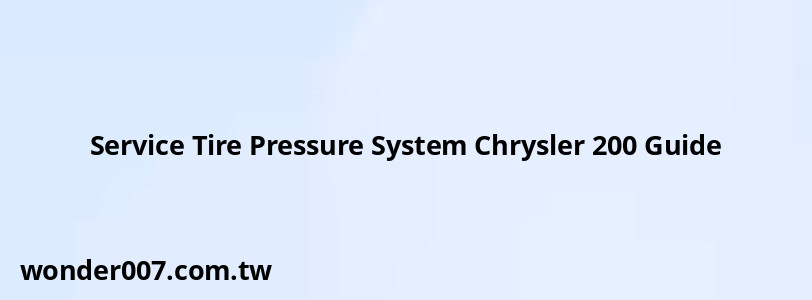Service Tire Pressure System Chrysler 200 Guide

The Service Tire Pressure System warning in a Chrysler 200 indicates an issue with the Tire Pressure Monitoring System (TPMS). This system is designed to monitor the air pressure in your vehicle's tires and alert you when one or more tires are significantly under-inflated. Understanding how to address this warning is crucial for maintaining your vehicle's safety and performance.
Understanding the TPMS
The TPMS in the Chrysler 200 continuously monitors the pressure in all four road tires (excluding the spare). It consists of tire pressure sensors attached to each wheel, a Wireless Control Module (WCM), and an indicator light on the dashboard. When the system detects low pressure in any tire, it illuminates a warning light and, in some models, displays the affected tire's location and pressure values.
Causes of Service Tire Pressure System Warning
Several factors can trigger the Service Tire Pressure System warning:
- Faulty TPMS sensors: One or more sensors may be malfunctioning or have dead batteries.
- System calibration issues: The system may need recalibration after tire rotation or replacement.
- WCM malfunction: The Wireless Control Module could be experiencing problems.
- Extreme temperature changes: Significant temperature fluctuations can affect tire pressure.
Addressing the Warning
If you encounter the Service Tire Pressure System warning, follow these steps:
1. Check tire pressures: Use a reliable tire gauge to check all tire pressures, including the spare.
2. Inflate tires: Adjust the tire pressures to the manufacturer's recommended levels.
3. Drive the vehicle: After inflation, drive for about 20 minutes at speeds above 15 mph (24 km/h) to allow the system to reset.
4. Sensor relearn procedure: If the warning persists, the system may need to relearn the sensor IDs.
Sensor Relearn Procedure
The Chrysler 200's TPMS is designed to automatically learn and store new sensor IDs while driving. After replacing a sensor:
1. Ensure all tires are properly inflated.
2. Drive the vehicle continuously for about 10 minutes at speeds above 15 mph (24 km/h).
3. The system should automatically recognize the new sensor.
When to Seek Professional Help
If the warning light remains on after following these steps, it's time to consult a professional. A certified technician can:
- Diagnose sensor issues: Using specialized tools to check each sensor's functionality.
- Perform a manual reset: Some models may require a specific reset procedure using a scan tool.
- Replace faulty components: If necessary, replace malfunctioning sensors or the WCM.
Maintaining Your TPMS
To ensure your TPMS functions correctly:
- Regular checks: Inspect tire pressures monthly, including the spare.
- Proper inflation: Always inflate tires to the recommended pressure, found on the driver's side door jamb.
- Rotate with care: When rotating tires, be aware that some systems may need recalibration.
- Use compatible parts: When replacing tires or wheels, ensure they are TPMS-compatible.
Importance of a Functioning TPMS
A properly working TPMS is crucial for:
- Safety: Helps prevent accidents caused by under-inflated tires.
- Fuel efficiency: Correctly inflated tires improve fuel economy.
- Tire longevity: Proper inflation extends tire life and ensures even wear.
Remember, while the TPMS is a valuable tool, it doesn't replace regular tire maintenance. Always visually inspect your tires and check pressures regularly to ensure optimal vehicle performance and safety.
FAQs About Service Tire Pressure System Chrysler 200
- Can I drive with the Service Tire Pressure System warning on?
While you can drive short distances, it's best to address the issue promptly to ensure safety and prevent potential tire damage. - How often do TPMS sensors need replacement?
TPMS sensors typically last 5-10 years, often needing replacement when their batteries die. - Will the TPMS warning turn off automatically after inflating tires?
In most cases, yes. However, you may need to drive for a short period at highway speeds for the system to reset.
Related Posts
-
2015 Nissan Murano: Comprehensive Fuse Box Guide
27-01-2025 • 205 views -
2011 Ford Escape Serpentine Belt Diagram: A Complete Guide
30-01-2025 • 136 views -
Side Mirror Replacement for 2016 Ford Fusion: A Complete Guide
29-01-2025 • 299 views -
Engine Oil Drain Plug Torque Chart: Essential Guide for Vehicle Owners
29-01-2025 • 291 views -
Oil Filter for Toyota Corolla 2003: A Comprehensive Guide
27-01-2025 • 253 views
Latest Posts
-
Are O2 Sensors Covered Under Warranty
01-02-2025 • 376 views -
Rear Brake Caliper Piston Won't Compress
01-02-2025 • 356 views -
How To Turn Off Paddle Shifters Mercedes
01-02-2025 • 377 views -
Power Steering Fluid Leak On Passenger Side
01-02-2025 • 457 views -
2015 Chevy Traverse AC Recharge Port Location
01-02-2025 • 409 views
Popular Posts
-
V12 Engine Costs: What You Need to Know
26-01-2025 • 679 views -
EPC Light: Understanding Causes and Solutions
26-01-2025 • 1053 views -
Power Steering and ABS Light On: Causes and Solutions
27-01-2025 • 643 views -
Hino Warning Lights: Understanding Dashboard Alerts
26-01-2025 • 765 views -
EPC Warning Light: What It Means for Your Vehicle
27-01-2025 • 630 views
